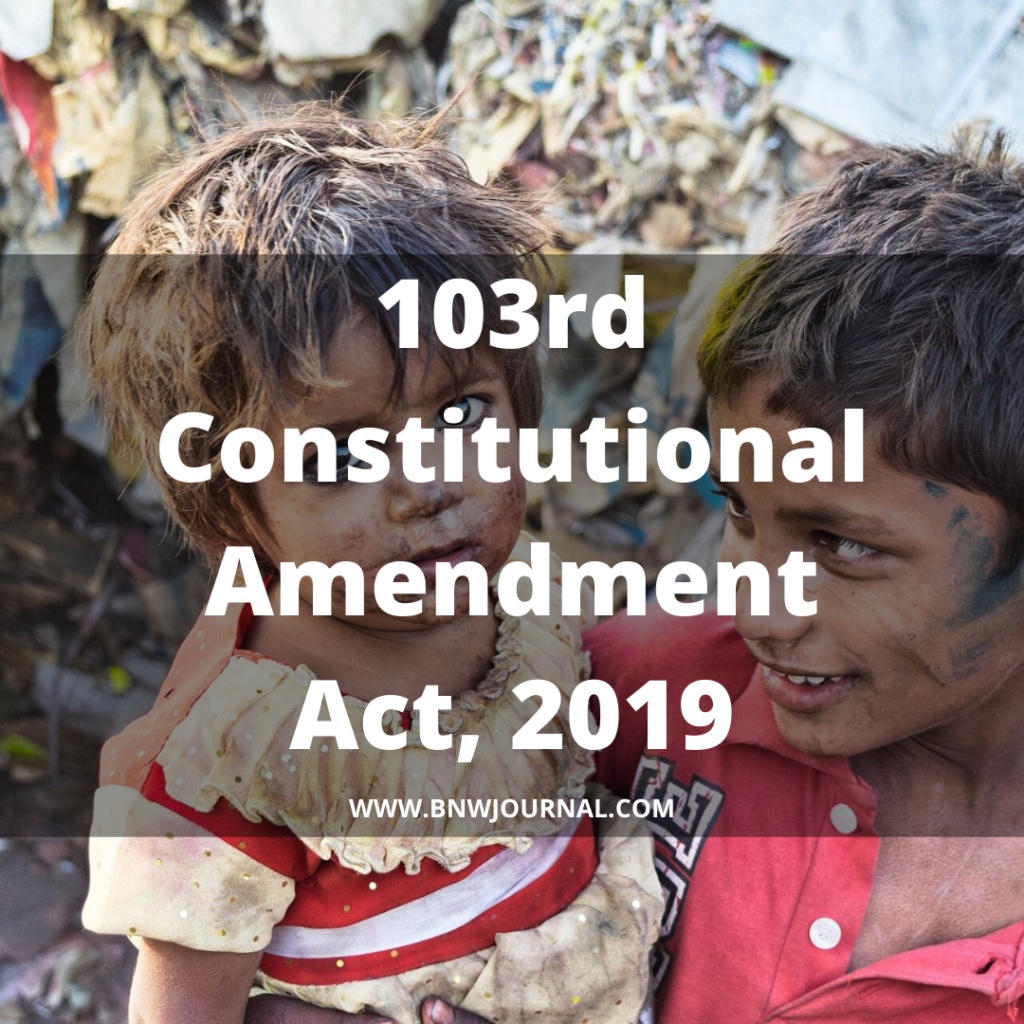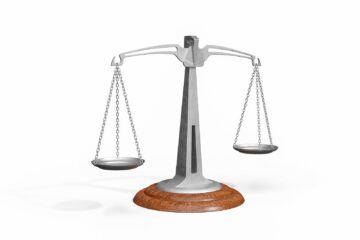![]()
“We must begin by acknowledging the fact that there is complete absence of two things in Indian society. One of these is equality. On the social plane, we have in India a society based on the principle of graded inequality; which means elevation for some and degradation for others. On the economic plane, we have a society in which there are some who have immense wealth as against many who live in abject poverty”.
B.R. Ambedkar[1]

Introduction
On 14th January 2019 the Constitution (103rd Amendment) Act, 2019 came into force, amending two articles of the Indian Constitution. They are Article 15 and Article 16. It insert 10% extra reservation for “Economically Weaker Section” (EWS) of the society. However it keep other sections aside i.e., Schedule Tribes (ST), Schedule Caste (SC), and Other Backward Class (OBC).
The new clause (6) in Art. 15 says that state has the power to make ‘Special Provisions’ for reservation of EWS in admission to educational institution; aided or unaided, keeping aside Art. 30(1) which guarantees the right to minority institutions. Likewise, clause (6) of Art. 16 includes the power of the state to have reservations for the post in the job.
This inclusion of a new reservation scheme will increase the reservation percentage to a total of 59.50% in the country.
Key points of 10 percent reservation-
The Ministry of Social Justice and Empowerment, on January 17, 2019 in its office Memorandum, Government of India. It stated that only the families whose gross annual income is less than Rs. 8 lakhs, agricultural land less than 5 acres, flat of less than 1,000 sq. ft., residential plot of less than 100 sq. yards comes under the benefit of reservation of EWS.
It is being said that this amendment brings inequality between various sections of the society. How it violates the right of equality as per Article 14 of the Constitution is also been stated herein.
We can say that Supreme Court, in its true sense, has always stated that economic weakness and backwardness is not the only point for reservation. And reservation is just given to those who are under-rated class/section of the society. It is not alone an anti-poverty program. But those were the time when Supreme Court reviews and ask for testing of executive orders and amendments which go against the Constitutional Provisions. But all that stands ineffective as now we have an amendment which itself validating economic weakness as the sole criteria for providing reservation.
Many a times Supreme Court has indeed stated that reservation should be provid keeping in all other social aspects and the basic right of equality in mind. It is said that it is not merely a direction, but, is a binding rule. The criteria for reservation is 50% which itself is being violated by the current amendment act.
Brief description of Art.15 and 16 of Indian Constitution
Article 15 states that ‘the State has no power to discriminate against any person based on religion, caste, sex, place of birth. Or anyone of them.’
Article 16 states that ‘there should be equal opportunity provide for all the citizens of the country. No discrimination should be done on the ground mentioned in Art.14 and on descent or residence.’
As we have also talk about Art.14 of the Constitution. It is state as ‘no state should hold people unequal before the law or unequal before the protection of law within the territory of India.’
Criticism
Now as many people are not satisfy with the decision. The only remedy to challenge this 103rd Amendment is by applying “Basic Structure Doctrine” for checking the validity as per the Constitution. The landmark case of Kesvananda Bharti v. State of Kerala[2], the Court held that the power of Parliament under Article 368 of Constitution for amendment is not absolute and if it is in violation with the ‘basic structure’ of the constitution, can be struck down by the hon’ble court. The term ‘basic structure’ is not anywhere under the Indian Constitution but is invent by Judiciary.
Standing on the doctrine, the court of law has dealt with many cases questioning some of the structural principles of the Constitution. Such as democracy opted by the State, Republican Government Policy, Federal System, Equality, Freedom of different density/nature, Secular nature, Judicial independence, and judicial review system. All the core and essential elements that are responsible for the functioning of the country are drag to courts. Whether, they are expressly mention and define or not in the rules. All were and still are answere by the Judiciary. All of these are beyond amendment. As the result of amending them leads to distortion of the Constitution and leads to a breakdown of the governing system.[3]
In Indira Nehru Gandhi v. Raj Narain[4], Supreme Court held that it is up to the court to tell determine case by case what comes under the ‘Basic Structure Doctrine’. Then, from time to time, the court has declared many principles as ‘basic’ by different Judges in different cases.
Conclusion
In India, the economically weaker and educationally backward section of the society uses their electoral and political power to advance their interest in the educational and employment sector. As mentioned earlier, Supreme Court always take a firm decision on the matter of Constitutional Amendments. The two grounds on which it has taken the binding decision are reservations up to “50% mark” and the “creamy layer” of the society. It is still to be clear whether the Supreme Court will strongly hold the ‘50 percent rule’ issue in most of the judgments or will go with the political currents which are going in the country.
References:
[1]1 Ambedkar, B.R. 1949. “Speech at The Constituent Assembly of India”, Indian National Congress, November
25, available at: https://www.inc.in/en/media/speech/speech-at-the-constituent-assembly-of-india (visited on May 3, 2020).
[2](1973) 4 SCC 225: AIR 1973 SC 1461
[3]K. Ashok Vardhan Shetty, “Can the Ten per cent Quota for Economically Weaker Sections Survive Judicial Scrutiny?”, available at: https://www.thehinducentre.com/publications/policy-watch/article26455910.ece/BINARY/Policy%20Watch%20No.9.pdf (visited on May 4, 2020).
[4](1975 AIR 865, 1975 SCR (3) 333).



0 Comments